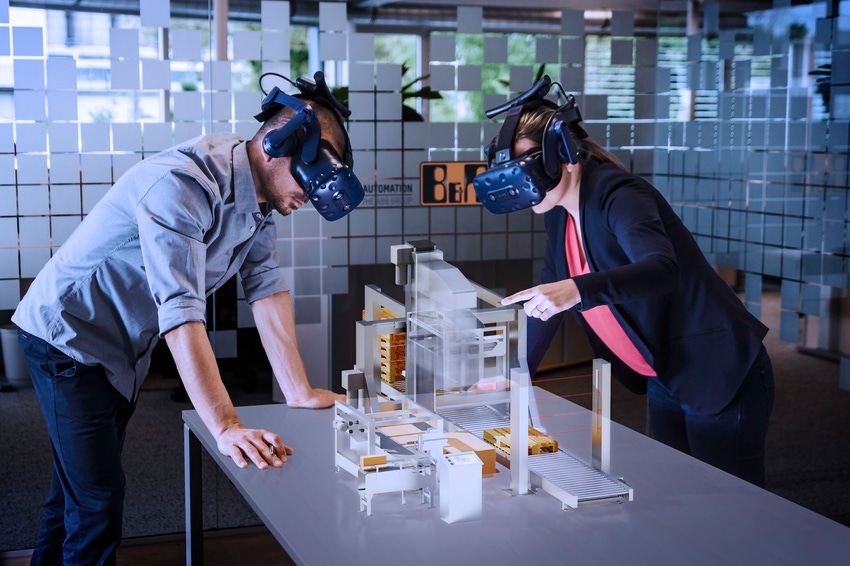Digital Twin Technology Is a Powerful Tool for Industrial Automation
Model-based design and simulation for industrial automation machine development takes a big step forward leveraging Digital Twin Technology.
October 9, 2019

Digital Twin technology has emerged as a potentially powerful tool for implementing automation and control applications. The technology offers a new approach that promises to enable model-based machine development.
|
Wearing VR or AR headsets, machine developers can use Digital Twin Technology to interact directly with their model, and directly connect to a B&R machine controller for testing. (Image source: B&R) |
At the most recent ODVA Technical Conference, Todd Snide and Merrill Harriman of Schneider Electric delivered an excellent paper on this topic describing the digital twin as the “cyber” part of Cyber Physical Systems. The idea is that the “digital twin” (a combination of software, hardware and communications) is “a representation of a physical entity indicating an ideal or object state of that entity, in constant comparison with its actual conditions.”
While it is a digital representation, the twin is directly associated with a physical device. Systems have a need for performance, which is being aided by new IoT communication developments, and an ability to support simulation and measurement/integration of real-time operation metrics.
From CAD Data to Digital Twin
B&R Automation has recently announced a new simulation tool for model-based machine development that integrates what they call “industrialPhysics simulation” into its Automation Studio engineering environment. It makes it possible for developers to directly import CAD data from machine components or entire machines to quickly and easily generate a digital twin for developing and testing machine software. Developers are able to run the virtual model of the machine on a PC, and then also directly connect it with the machine controller.
|
New software tools powered by Digital Twin technology make it easier to transfer useful live information and update machine parameters without the need for additional programming, making full use of the improved data transparency. (Image source: Mitsubishi & CONTACT Software) |
Digital Twin data is imported in STEP format which includes properties of the CAD design such as mass and density, and enables machine designers to view the behavior of the machine in real time. The tool can also be used to simulate the flow of materials through the line to identify potential problem areas. An additional bonus is viewing the machine model using virtual reality (VR) or augmented reality (AR) headsets.
IoT Software Elements
CONTACT Software, a new member of Mitsubishi Electric’s e-F@ctory Alliance, has introduced Using Elements for IoT software which enables the lifecycle of machinery to be managed from a single reference point. Starting with CAD files of the equipment, a virtual operational model is built-up, and then connected to a physical production site.
This approach uses live data from machine tools, robots, PLCs and other smart devices to create a digital twin. The twin is then used to achieve maintenance on-demand, it can reliably predict service requirements, improving operational efficiency and reducing downtime.
Parameterizing connections to the machines makes it easier to transfer useful live information without additional programming, making full use of the improved data transparency. This kind of data transparency for individual machines and devices across multiple locations allows for efficient planning, management and predictive maintenance.
Cross-Domain Virtual Models
A final application example of Digital Twin technology is how Siemens is implementing cross-domain virtual models in software that accurately represents a product or production. Using this approach, data collected with IIoT platforms provides detailed insights into production operations.
By connecting this information to high fidelity digital twin models, the goal is that companies can create a consistent digital thread that enables them to speed up development, optimize manufacturing processes and improve products for their next version or iteration with real-time insights.
By combining MindSphere with Siemens’ Teamcenter software product data management collaboration tool, the digital twin evolves and continuously updates to reflect any change to the physical counterpart throughout the lifecycle to create closed-loop feedback in a virtual environment.
Finally Model-based Design
Snide and Harriman have predicted that “digital twins will be a major feature of all automation systems in the near future. It is a matter of what one puts in the digital twin not IF one wants to design a digital twin. The digital twin will be a common part of the system.
I highly recommend reading their paper for an overview of this technology, and more information on design implications and how Digital Twin Technology will be useful and implemented in CIP and EtherNet/IP networks.
Al Presher is a veteran contributing writer for Design News, covering automation and control, motion control, power transmission, robotics, and fluid power.
The Midwest's largest advanced design and manufacturing event! |
About the Author(s)
You May Also Like






